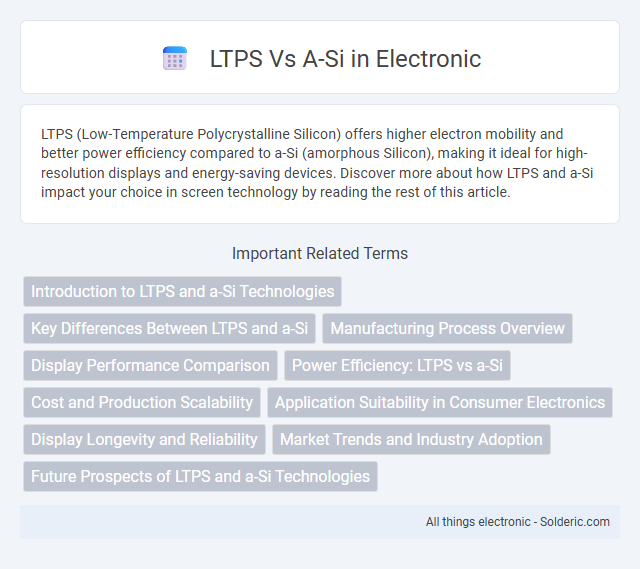LTPS (Low-Temperature Polycrystalline Silicon) offers higher electron mobility and better power efficiency compared to a-Si (amorphous Silicon), making it ideal for high-resolution displays and energy-saving devices. Discover more about how LTPS and a-Si impact your choice in screen technology by reading the rest of this article.
Comparison Table
| Feature | LTPS (Low-Temperature Polycrystalline Silicon) | a-Si (Amorphous Silicon) |
|---|---|---|
| Structure | Polycrystalline silicon with ordered grains | Non-crystalline silicon |
| Electron Mobility | Higher (~100 cm2/V*s) | Lower (~0.5-1 cm2/V*s) |
| Manufacturing Temperature | ~600degC (low temperature for polycrystalline films) | Below 300degC |
| Display Resolution | High (supports high pixel density) | Moderate (suitable for lower resolutions) |
| Cost | Higher production cost | Lower production cost |
| Applications | Smartphones, high-end displays, OLED screens | Large-size LCDs, budget devices |
| Power Consumption | Lower due to higher mobility | Higher power consumption |
| Lifetime | Generally longer lifespan | Shorter lifespan |
Introduction to LTPS and a-Si Technologies
LTPS (Low-Temperature Polycrystalline Silicon) technology offers high electron mobility and enhanced pixel density, making it ideal for high-resolution displays and advanced OLED panels. Amorphous Silicon (a-Si) technology, characterized by lower production costs and simpler manufacturing processes, is widely used in large-area LCD screens with moderate resolution requirements. LTPS enables faster transistor switching speeds and improved energy efficiency compared to a-Si, which has slower performance due to its disordered silicon structure.
Key Differences Between LTPS and a-Si
LTPS (Low-Temperature Polycrystalline Silicon) offers higher electron mobility and faster switching speeds compared to a-Si (amorphous Silicon), enabling superior display resolution and responsiveness. a-Si panels are generally more economical to produce and consume less power but exhibit lower performance in terms of pixel density and stability. The key differences stem from their material structures, with LTPS being crystalline and more efficient, while a-Si remains amorphous and cost-effective for large-area displays.
Manufacturing Process Overview
LTPS (Low-Temperature Polycrystalline Silicon) displays require a more complex manufacturing process involving polycrystalline silicon deposition and crystallization at temperatures below 600degC, allowing integration on glass substrates without damage. In contrast, a-Si (amorphous Silicon) panels are produced using a simpler, low-temperature PECVD (Plasma Enhanced Chemical Vapor Deposition) process that deposits silicon in an amorphous form directly on substrates. Your choice between LTPS and a-Si depends on desired resolution, manufacturing cost, and power efficiency, with LTPS offering higher performance but more intricate production steps.
Display Performance Comparison
LTPS displays offer higher electron mobility than a-Si, resulting in faster pixel response times and improved display performance. This technology enables higher resolution and greater brightness, making it ideal for smartphones and high-end devices. You can expect sharper images and better energy efficiency with LTPS compared to traditional a-Si displays.
Power Efficiency: LTPS vs a-Si
LTPS (Low-Temperature Polycrystalline Silicon) displays significantly higher power efficiency compared to a-Si (amorphous Silicon) due to its superior electron mobility, which enables faster charge transport and lower power consumption in displays. LTPS panels can reduce energy usage by up to 30% compared to a-Si, making them ideal for high-resolution, battery-powered devices like smartphones and tablets. The reduced leakage current and enhanced driving capabilities of LTPS also contribute to longer battery life and improved overall device performance.
Cost and Production Scalability
LTPS (Low-Temperature Polycrystalline Silicon) displays higher production costs due to complex manufacturing processes compared to a-Si (amorphous silicon), which benefits from simpler and more mature fabrication techniques. a-Si offers greater scalability with lower capital investment, making it suitable for large-area displays and mass production. LTPS production is more limited by equipment precision and throughput, impacting its cost-effectiveness for high-volume applications.
Application Suitability in Consumer Electronics
LTPS (Low-Temperature Polycrystalline Silicon) offers higher electron mobility and increased resolution, making it ideal for high-performance displays in smartphones, tablets, and laptops where sharp visuals and fast refresh rates are crucial. a-Si (amorphous Silicon) is cost-effective and energy-efficient but generally suits lower-resolution screens such as those in budget TVs and secondary displays due to its slower electron mobility. Choosing the right technology influences Your device's display quality, power consumption, and overall user experience in consumer electronics.
Display Longevity and Reliability
LTPS (Low-Temperature Polycrystalline Silicon) displays offer significantly enhanced longevity and reliability compared to a-Si (Amorphous Silicon) panels due to their superior electron mobility and reduced degradation rates under prolonged use. LTPS technology supports higher pixel densities and maintains consistent performance over time, making it ideal for devices requiring long-term durability such as smartphones and wearables. In contrast, a-Si displays tend to suffer from faster pixel deterioration and lower overall lifespan, limiting their effectiveness in high-end or mission-critical applications.
Market Trends and Industry Adoption
LTPS displays stronger market adoption in high-resolution displays for smartphones and tablets due to its superior electron mobility and energy efficiency compared to a-Si. While a-Si remains prevalent in large-area applications like TVs and monitors because of lower manufacturing costs, LTPS drives innovation in premium segments with faster processing speeds and enhanced image quality. Your choice between LTPS and a-Si depends on prioritizing performance benefits versus cost-effectiveness aligned with industry trends.
Future Prospects of LTPS and a-Si Technologies
LTPS (Low-Temperature Polycrystalline Silicon) displays significant potential for future display innovation due to its superior electron mobility, enabling higher resolution and faster refresh rates compared to a-Si (amorphous Silicon). Advancements in LTPS manufacturing, such as improved process scalability and cost reduction, drive its adoption in high-end smartphones, tablets, and wearable devices. Conversely, a-Si technology maintains relevance in large-area, cost-sensitive applications like TVs and monitors, but faces limitations in performance enhancements and energy efficiency compared to LTPS.
LTPS vs a-Si Infographic

 solderic.com
solderic.com